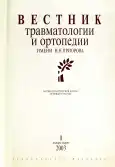Possibilities of computed tomography in the complex assessment of scoliotic spinal deformity
- Authors: Vetrile S.T.1, Morozov A.K.1, Kisel A.A.1, Kuleshov A.A.1, Kosova I.A.1
-
Affiliations:
- Central Institute of Traumatology and Orthopedics. N.N. Priorova
- Issue: Vol 10, No 1 (2003)
- Pages: 11-20
- Section: Original study articles
- URL: https://journal-vniispk.ru/0869-8678/article/view/48239
- DOI: https://doi.org/10.17816/vto200310111-20
- ID: 48239
Cite item
Full Text
Abstract
Complex evaluation of scoliotic deformity was performed using CT. Fifty patients with displastic scoliosis of III—IV degree were examined before and after surgical intervention — dorsal correction and spine fixation with Cotrel-Dubousset instrumentation. No marked derotation of spine at the deformity apex was noted postoperatively. Changes of thorax in the plane of apical vertebra were studied and quantitatively evaluated: postoperatively thorax became of more correct oval shape in all cases. Density of trabecular bone of apical and neutral vertebrae coincided with the understanding about asymmetry of deformed vertebrae bone density. No marked immediate postoperative changes were noted. Combination of CT and myelography showed the dislocation of dural sac to the side opposite to the deformity convexity; either partial (up to 60—70% in patients with deformity of III and early IV degree) or complete (in patients with severe deformity) disturbance of contrast distribution in subarachnoidal space from concave side and compensatory widening of subarachnoidal space from the opposite side with maximum changes at the apex of scoliotic deformity.
Keywords
Full Text
##article.viewOnOriginalSite##About the authors
S. T. Vetrile
Central Institute of Traumatology and Orthopedics. N.N. Priorova
Email: info@eco-vector.com
Russian Federation, Moscow
A. K. Morozov
Central Institute of Traumatology and Orthopedics. N.N. Priorova
Email: info@eco-vector.com
Russian Federation, Moscow
A. A. Kisel
Central Institute of Traumatology and Orthopedics. N.N. Priorova
Email: info@eco-vector.com
Russian Federation, Moscow
A. A. Kuleshov
Central Institute of Traumatology and Orthopedics. N.N. Priorova
Email: info@eco-vector.com
Russian Federation, Moscow
I. A. Kosova
Central Institute of Traumatology and Orthopedics. N.N. Priorova
Author for correspondence.
Email: info@eco-vector.com
Russian Federation, Moscow
References
- Васюра А.С., Новиков В.В., Михайловский М.В., Сар- надский В.Н. //Конф, молодых ученых «Новое в решении Актуальных проблем травматологии и ортопедии»: Тезисы докладов. — М., 2000. — С. 120.
- Копылов В.С., Потапов В.Э. //Съезд травматологов- ортопедов России, 7-й: Тезисы докладов. — Новосибирск, 2002. — С. 143.
- Мовшович И.А., Риц И.А. Рентгенодиагностика и принципы лечения сколиоза. — М., 1969.
- Потапов В.Э., Копылов В.С., Сороковиков В.А. и др. //Съезд травматологов-ортопедов России, 7-й: Тезисы докладов. — Новосибирск, 2002. — С. 163.
- Сарнадский В.Н., Фомичев Н.Г., Вилъбергер С.Я. //Там же. — С. 166.
- Aaro S., Dahlborn М. //Spine. — 1981. — Vol. 6. — Р. 567-572.
- Aaro S., Dahlborn M. //Ibid. —1981. — Vol. 6. — P. 460- 467.
- Dubousset J., Graf H., Miladi L., Cotrel Y. //Orthop. Trans. — 1986. — Vol. 10. — P. 36.
- Erker M.L., Betz R.R. //Spine. — 1988. — Vol. 13. — P. 1141-1144.
- Krismer M., Sterzinger W. //Ibid. — 1996. — Vol. 21. — P. 576-581.
- Lenke L.G., Bridwell K.H., Baldus С. // І. Bone Jt Surg. — 1992. — Vol. 74A. — P. 1056-1067.
- Malcolm J., Wind G. //Spine. — 1990. — Vol. 15. — P. 871-873.
- Mazess R.B. // Calcif. Tiss. Int. — 1984. — Vol. 36. — P. 8-13.
- Porter R.W. //Spine. — 2000. — Vol. 25. — P. 1360- 1366.
Supplementary files





















